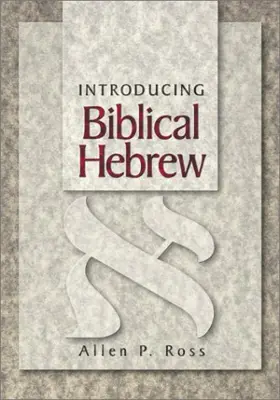

Introducing Biblical Hebrew
Pages
576
Publisher
Baker Academic
Published
2001
ISBN-13
9780801021473
This first-year grammar has grown out of the author's experience in teaching Hebrew to seminary students for over thirty years. Through those many years of classroom use, Dr. Ross has developed and refined his explanations, exercises, and examples to provide students with an effective introduction to Biblical Hebrew.
In addition to traditional deductive methods and exercises, Introducing Biblical Hebrew includes inductive sections that provide practical translation experience as the student works through passages from the Book of Genesis. In addition, there are well-paced vocabulary and grammar exercises and practical guides to the more technical features of the Hebrew Bible.
First year Hebrew students in Bible college, seminary, christian college, or a university setting will find Introducing Biblical Hebrew to be one of the most useful and balanced textbooks available.
Reviews
thorough introductory grammar.
[Full Review]
Introducing Biblical Hebrew by Ross is a prime example of an exercise book written forstudents to facilitate their understanding and learning of the basic principles of thelanguage and to prepare them for advanced studies. The material is presented in fifty-fourlessons subdivided into three principal parts and preceded by a short introduction intoSemitic languages in general and the preservation of Biblical Hebrew in particular(11–16). Lessons 1–6 concentrate on the signs and sounds—consonants and vowels,shewa, dagesh, and quiescent letters—and introduce the use of the article and inseparableprepositions (17–67). Lessons 7–40 deal with the morphology of the noun, pronoun, andpronominal suffix; regular and irregular verbs along with proposals for a mechanicalparsing method; and elementary syntax (69–307). The lessons in parts 1 and 2 list somevocabulary categorized as verb, noun, or other form and offer some exercises. Lessons41–54 explore syntactical issues and the use of the Biblia Hebraica Stuttgartensia(309–422). The lessons in part 3 provide a detailed study of morphology and syntax ofportions taken from Gen 2–4 and 12–15, concluded by a review of the grammar andsyntax found in these texts with cross-references to the full discussion in parts 1 and 2.The last part of the book presents a number of study aids: summaries of the lessons 1–54(425–78), a Hebrew-English Glossary (479–506), an English-Hebrew glossary (507–43),paradigms of the regular and irregular verbs (544–55), and two tables with the MasoreticAccents. The book is complemented by a subject index (557–65).
[Full Review]

